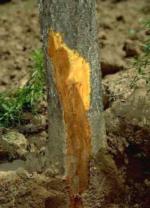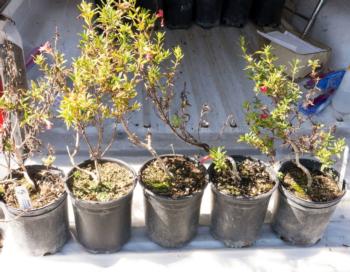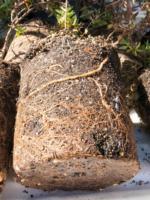The Plant Doctor
Phytophthora Crown and Root Rot In Potted Plants
With the end of a rainy winter and spring, certain diseases have been supported by the wet and cool conditions. Phytophthora are worldwide-recognized plant pathogenic microorganisms, many of which cause root and collar rot diseases and complete their lifecycle in the presence of water. Phytophthora release swimming spores that move through water and are attracted to plant root exudates. The conditions created in the root environment of potted plants exacerbate the problem, and crown and root rots are frequently seen on plants in pots.

Fig 2. Phytophthora has developed up into the trunk crown, just above the soil line. The brown tissue is the wood that has been killed. Photo: UC IPM.

Fig 1. Diplacus aurantiacus 'Trish' showing above ground symptoms because of various degrees of Phytophthora root rot. Photo: S. Tjosvold.
Once susceptible plant roots are infected, the pathogen can cause root rot. At first, leaves can be smaller than normal and have chlorosis or interveinal chlorosis (Fig 1). The disease can develop up into the root crown near the soil line. When
Phytophthora infects at or develops into the root crown near the soil line, the disease is described as a “crown rot.” At this stage, leaves may droop and the plant dies even with adequate soil moisture. Cutting just under the bark at or just above the soil line may reveal dead inner bark tissue (Fig 2). The dead tissue may be reddish brown, brown, or black and will differ from healthy tissue, which can be white, green, or pink depending on the type of plant or tissue.

Fig 3. Sticky monkeyflower with Phytophthora root rot. All fine feeder roots are infected and necrotic. Photo: S. Tjosvold.
Root balls must be examined by carefully removing the pot to expose the roots. Sometimes gently shaking, or washing the soil mix from the outer portion of the rootball, can allow for a better examination. Diseased roots can be reddish brown to dark brown while healthy roots are often white to tan, depending on the plant species (Fig 3). Feeder roots can be rotted away, and heavier roots can be discolored. Fleshy roots of some plant species can be brown, water-soaked and flaccid. They may also be brittle, thin and rotted inside, while healthy roots are often turgid and crisp.
There are no good control measures for this disease. There are no fungicides that cure the disease once roots are infected. It is best to insure that you buy healthy uninfected plants from reputable suppliers. Provide irrigation and drainage that minimizes water-logged soil conditions. For more information on Phytophthora crown and root rot in the garden, visit our IPM website here. For quick tips on diagnosis and management of Phytophthora crown and root rot, visit this IPM website. If you have questions, contact us online, by phone or in person to get answers to your gardening quandaries!



